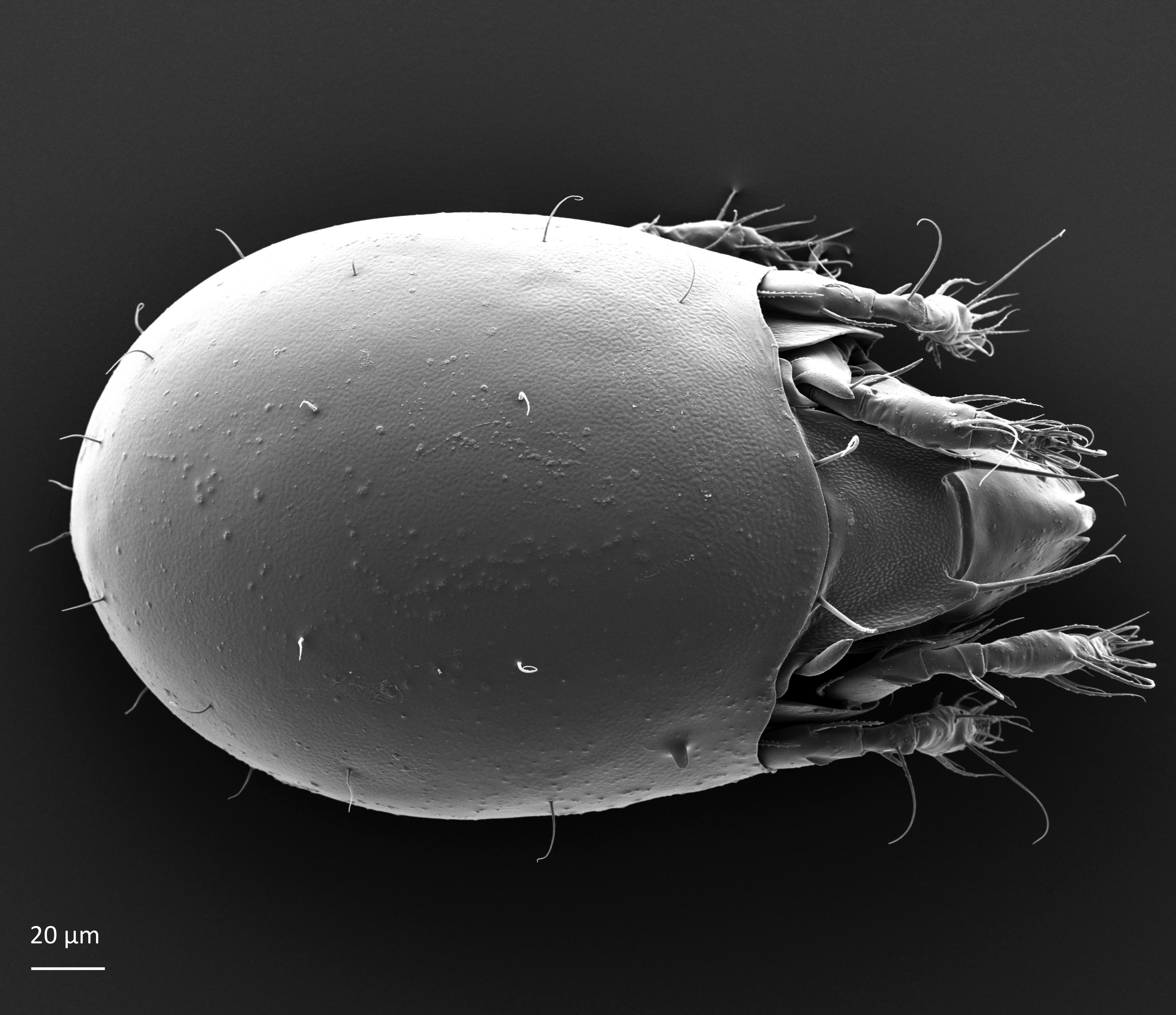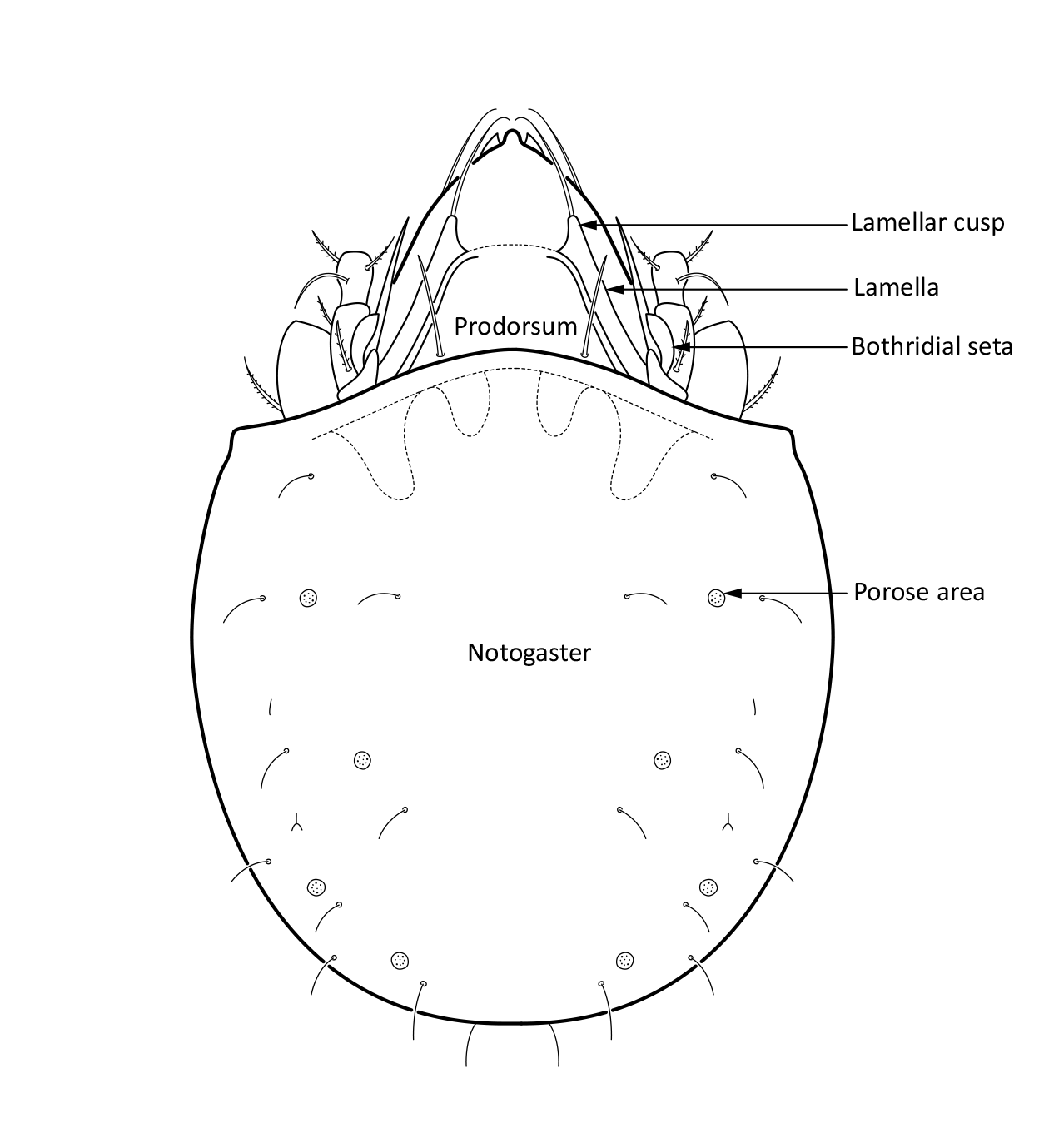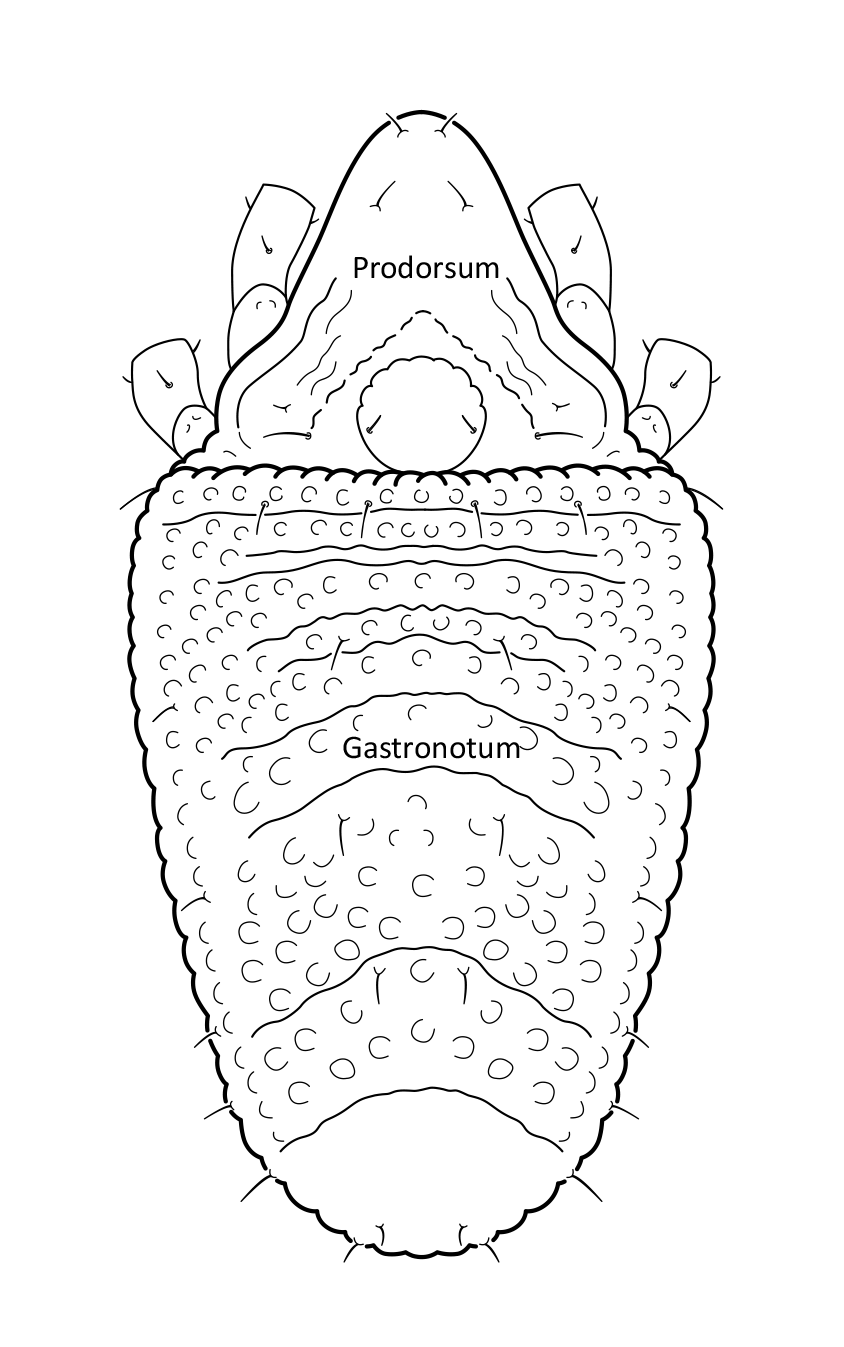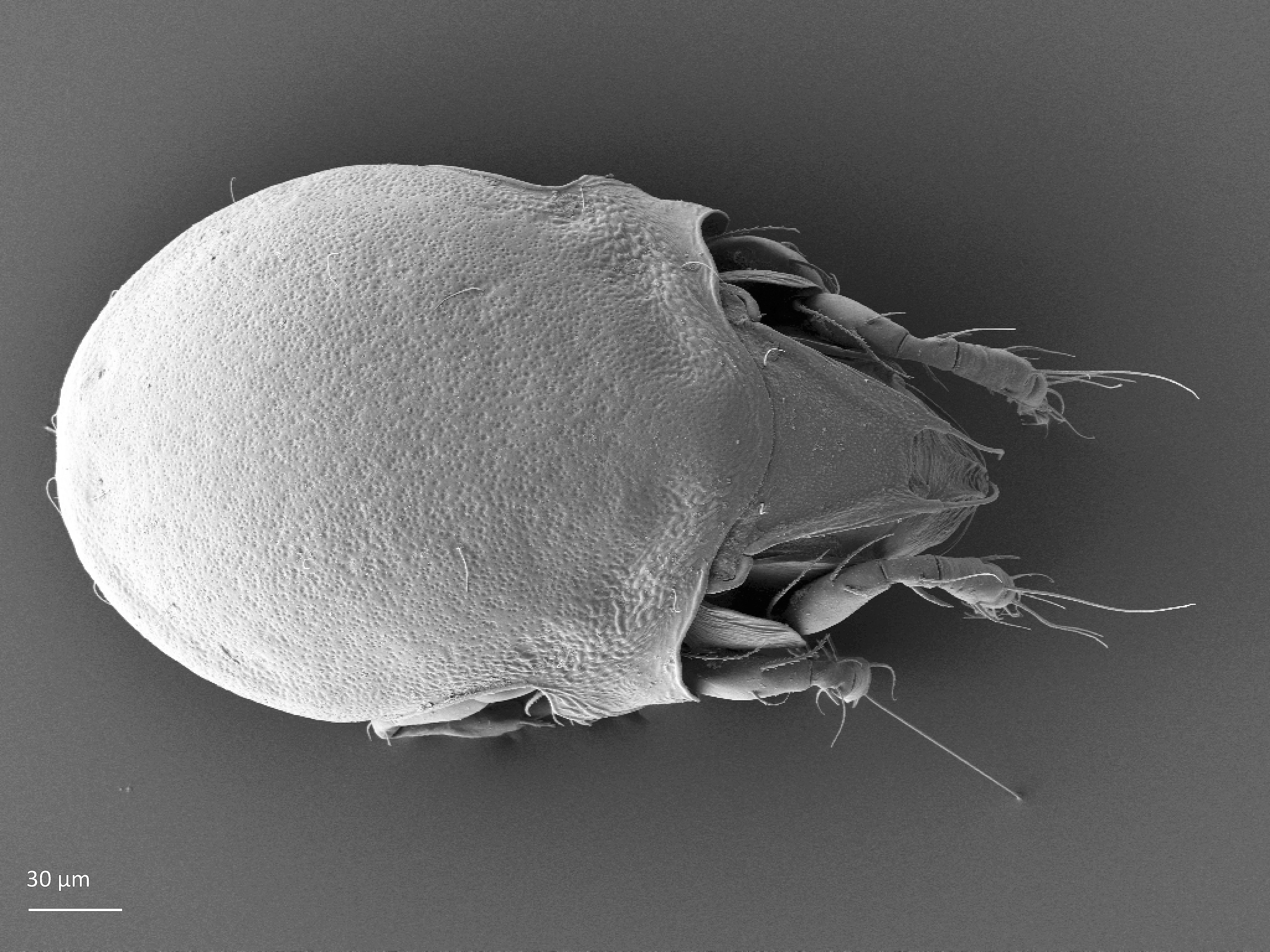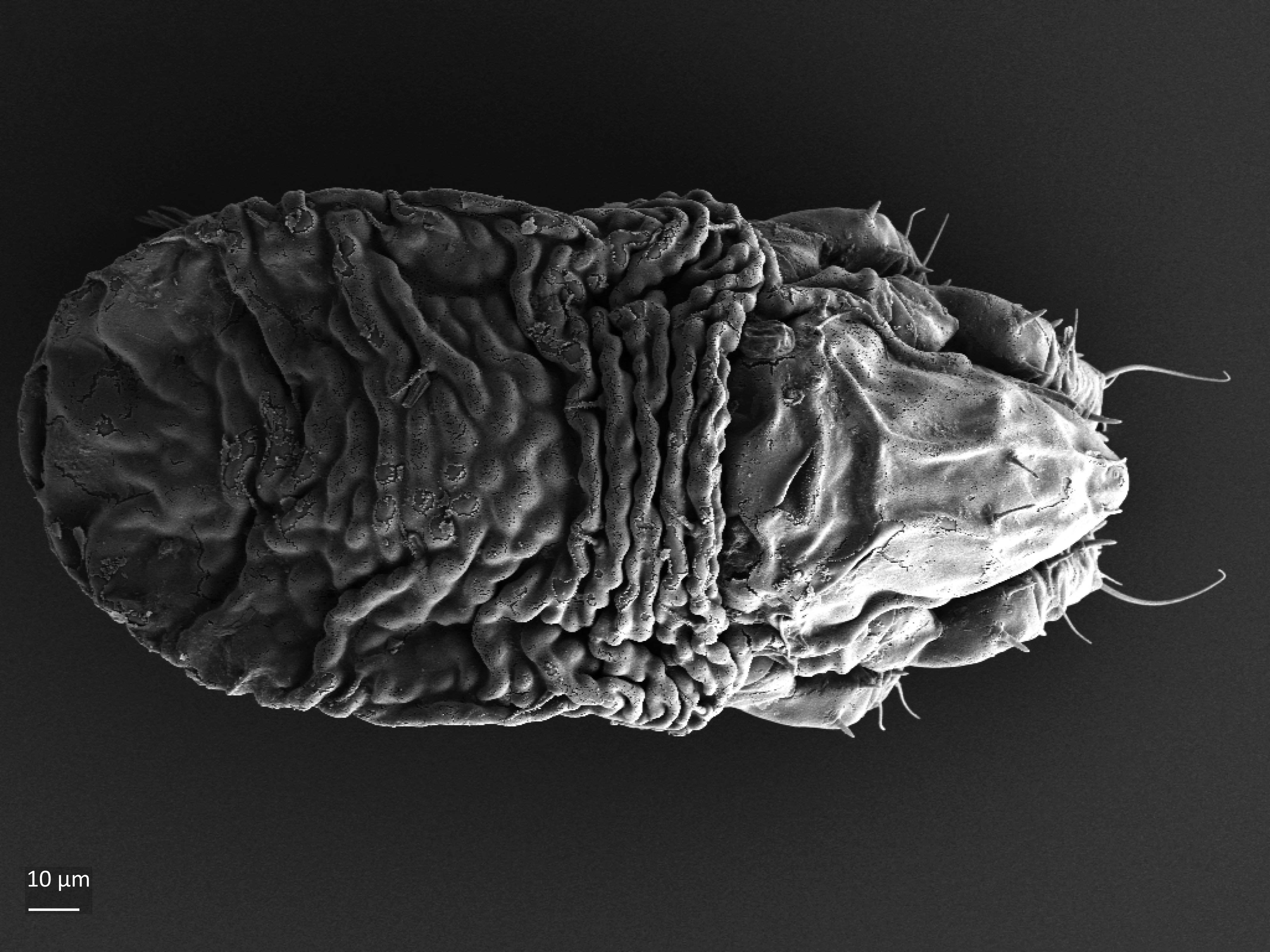Ceratozetes parvulus
Ceratozetes parvulus is a common species in peatlands, where it prefers drier microhabitats, like hummocks. Both its adults and juveniles have some morphological characters which are unique in the family Ceratozetidae. The juvenile stages of Ceratozetes parvulus have been described recently from Norwegian mires. Their identity was confirmed with DNA barcoding.
- Innhold
- Description
- Look-alikes
- Biology
- Ecology
Description
Adult: The length of the body is on average 281 µm and the width is 175 µm. The body is light brown. Notogaster has 10 pairs of setae of medium size and 4 pairs of small, rounded porose areas (Fig. 1). The prodorsum has a pair of narrow lamellae with short cusp, translamella is absent. Bothridial seta is short, clavate and has barbed, and distally rounded head (Behan-Pelletier 1985, Weigmann 2006, Behan-Pelletier and Eamer 2009, Seniczak and Seniczak 2021).
Juvenile stages: Larva: body length 178 µm, width 90 µm. Protonymph: body length 205 µm, width 99 µm. Deutonymph: body length 254 µm, width 122 µm. Tritonymph – body length 304 µm, width 160 µm. The color is white. They are egg-shaped in dorsal view and have cuticle with tubercles (Figs. 2 and 3). Prodorsal and gastronotal setae are short and smooth. Bothridial seta is setiform, of medium size (Seniczak and Seniczak 2021).
Fig. 1. Dorsal view of Ceratozetes parvulus, adult.
Fig. 2. Dorsal view of Ceratozetes parvulus, juvenile (tritonymph).
Look-alikes
When sorting peatland material under a stereomicroscope, Ceratozetes parvulus may resemble another common peatland species, Limnozetes ciliatus (Schrank, 1803), by the size, color and the shape of adults and juveniles. But many differences are seen by looking at the details. The adult of Ceratozetes parvulus has 4 pairs of porose areas on the notogaster, while Limnozetes ciliatus lacks porose areas. The body of Ceratozetes parvulus is not slimmer behind the pteromorphs (wing-like structures), while in Limnozetes ciliatus it is clearly slimmer. On the prodorsum of Ceratozetes parvulus translamella is absent, while in Limnozetes ciliatus it is present. In juveniles of Ceratozetes parvulus all setae on gastronotum (main body) are short and smooth, while in Limnozetes ciliatus peripheral setae are thick, stiff, and rather long.
Biology
The species is probably parthenogenetic, that is females are produced from unfertilized eggs. Its feeding preferences and time of development are unknown.
Fig. 3. Dorsal view of Ceratozetes parvulus, juvenile (tritonymph).
Ecology
In Trøndelag, at the end of June 2020, the adults dominated in the extracted samples (74%), and the tritonymphs were absent. In Finse, at the beginning of August 2018, adults also dominated (53%), and Ceratozetes parvulus was represented by all developmental stages. About 10% of the females were gravid, each carrying one egg. Ceratozetes parvulus occurred in different peatland habitats, but clearly preferred drier conditions. It was most abundant in hummocks, where it occurred in almost all samples, and juveniles were more abundant there than in the other microhabitats (Seniczak and Seniczak 2021).
Distribution
Ceratozetes parvulus has a Holarctic distribution (Subías 2004), that is in the northern continents of the world.
Habitat
Ceratozetes parvulus is a common oribatid species in Sphagnum-dominated peatlands. It has been found in 40% of a total of about 50 studied Holarctic bogs but was not abundant (Mumladze et al. 2013). In Finse, it occurred abundantly at the edge of a pond, overgrown by Sphagnum mosses; it achieved the density of 17,800 ind./m2. In Atlantic raised bogs it was found in different habitats (hollow, lawn, hummock), but was most abundant and occurred with the highest constancy (in 97% of samples collected) in hummocks. In hollows, for example, it only occurred in 20% of the samples (Seniczak and Seniczak 2021).
Findings in Norway
In Norway, one specimen of Ceratozetes parvulus was reported from the area near Oslo by Sig Thor in 1937. Later, there have been several studies in peatlands without the species being recorded. However, recently it has been found abundantly, and with all its developmental stages, in peatlands in Finse (Vestland) and in Hitra and Høstadmyra (Trøndelag) (Seniczak and Seniczak 2021).
References
Behan-Pelletier VM (1985). Ceratozetidae of the western North American Arctic. The Canadian Entomologist, 117, 1287– 366. doi.org/10.4039/Ent1171287-11
Behan-Pelletier VM and Eamer B (2009). Ceratozetes and Ceratozetoides (Acari: Oribatida: Ceratozetidae) of North America. The Canadian Entomologist, 141, 246–308. doi.org/10.4039/n09-023
Mumladze L, Murvanidze M and Behan-Pelletier V (2013). Compositional patterns in Holarctic peat bog inhabiting oribatid mite (Acari: Oribatida) communities. Pedobiologia, 56(1), 41–48. doi.org/10.1016/j.pedobi.2012.10.001
Subías LS (2004). Listado sistemático, sinonímico y biogeográfico de los ácaros oribátidos (Acariformes, Oribatida) del mundo (excepto fósiles). Graellsia 60 (número extraordinario), 3–305.
Seniczak A and Seniczak S (2021). Morphological ontogeny and ecology of Ceratozetes parvulus (Acari: Oribatida: Ceratozetidae). Zootaxa 5086(1), 111–134. doi.org/10.11646/zootaxa.5086.1.9
Thor S (1937). Übersicht der norwegischen Cryptostigmata mit einzelnen Nebenbemerkungen. Nyt Magazin for Naturvidenskaberne, 77(1), 275–307.
Weigmann G (2006). Hornmilben (Oribatida). Die Tierwelt Deutschlands. 520 pp. Vol. 76, Goecke and Evers, Keltern.
